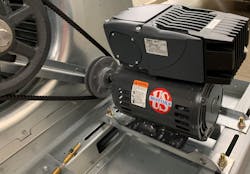Integrated Motor Drives Poised to Become HVAC Industry Standard
By JIM ELLIS, Nidec Motor Corporation
Special to HPAC Engineering
Ever more stringent building energy regulations and carbon efficiency standards are causing a shake-up in the commercial HVAC market. When the dust settles, integrated motor and control (IMAC), an energy-saving technology that pairs a high-efficiency motor with a variable frequency drive (VFD) or on-board control, is expected to emerge as the new standard for commercial and industrial HVAC and fan applications.
The switch is driven primarily by an IMAC’s ability to adjust HVAC blower speed automatically based on system demand. The result is an HVAC system that can operate with near-equal efficiency at a variety of speeds.
U.S. Department of Energy (DOE) research shows that reducing IMAC speed by 20% when demand drops can slash input power requirements in half. Given the demand fluctuations in daily real-time operation, the energy savings associated with IMAC usage can be substantial.
Consider for example a situation where engineers design commercial HVAC systems to include both variable speed and single-speed fans. The single-speed fan serves as the base, or constant load, while the variable-speed fan adjusts speed to maintain the system’s overall target air pressure, creating the variable load.
Recent research from the Northwest Energy Efficiency Alliance (NEEA) found that IMACs and other power drive systems (PDS) cut energy usage by up to 45% for variable load systems and 23% for constant load systems. According to NEEA calculations, IMAC solutions pay for themselves in about 10 months for constant load systems and only four months for variable load systems.
Use of synchronous motors cut energy consumption even more. In some cases, it is possible to improve full-load efficiency by one to two points and part-load efficiency by seven to 15 points, resulting in dramatic incremental savings.
And thanks to the new Power Index (PI) established by NEMA MG 10011-2022, engineers can now make apples-to-apples comparisons of the energy savings associated with individual IMACs and other PDSs. Created to support DOE’s evolving energy savings rules, the PI index is specifically designed for power electronics like the IMAC that have expanded the performance envelope.
The PI Index demonstrates that an IMAC that adjusts to run at the speed required by a system at any given time can achieve significant energy and cost savings. A review of average motor loads nationwide also suggests that many products in the field today are oversized, offering the engineer additional savings opportunities when incorporating an IMAC.
Beyond energy savings
The DOE recommends VFDs like those found on IMACs for fans powered by 1- to 1,000-horsepower motors. IMACs are already the most common way to power multi-speed residential heating and air conditioning blowers in the U.S.
Commercial markets are now following the residential market’s lead. Many HVAC engineers cite not only the energy savings IMACS deliver, compared to lower-efficiency permanent split capacitor (PSC) motors, but they also prefer other IMAC benefits associated with installation, supply chain and service-related issues.
For one thing, most IMAC motor parameters and fan configuration details are programmed into the drive at the factory. Once onsite, IMAC design also eliminates the need for wiring between the motor and the control. Many IMACs also do not require shaft ground rings and other expensive motor features associated with motors used with VFD or VSD controls.
All this makes these solutions easier and less risky to install than single-speed motors and separate VFDs. In fact, a typical IMAC installation manual runs under 30 pages. That’s less than one-third the length of typical control manuals.
Data collected during IMAC operations can also be fed into building management systems, which provide users with the insights needed to make time-sensitive decisions and react quickly to turn blowers on and off as circumstances change. Because they can communicate to building automation systems (BAS) and sensors, these solutions also help meet other organizational goals, including the transition to smart building technology.
To further simplify installation, most manufacturers design their IMACs to fit into the same space and location as the motors they replace. By using the same base mounting dimensions as single-speed motors, IMACs may be dropped into the place of the old solution, with the drive placed on top of the motor. Engineers need only consider motor clearance when preparing for installation.
Because the motor and control on an IMAC are designed to work together, the control is optimized to be compatible with the motor it drives. This helps prevent issues sometimes caused by the over-design of the control or motor. These solutions can also be programmed to maximize its efficiency on a particular heating and air conditioning unit by running at a specific speed or torque point.
The bottom line
As HVAC engineers seek to comply with looming building energy regulations from DOE as well as states and municipalities, an increasing number are gravitating toward IMAC solutions. So, expect demand for IMACs will continue to grow. They are where the motor industry is headed.
##########
Based in St. Louis, the author is director of marketing, residential & commercial pumping, for Nidec Motor Corporation.

